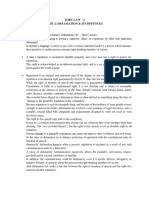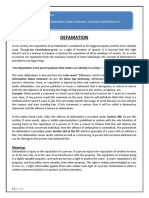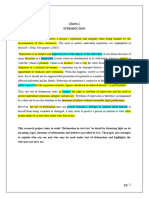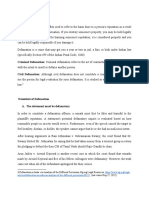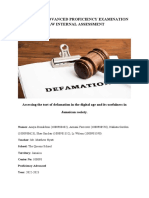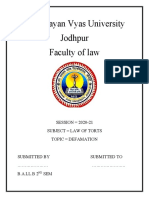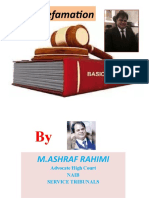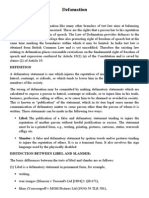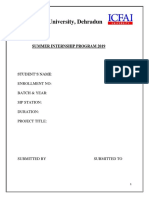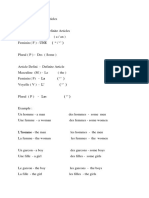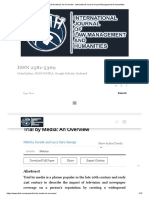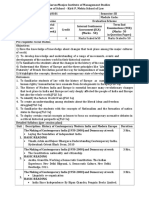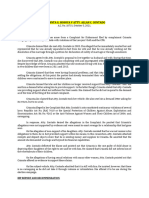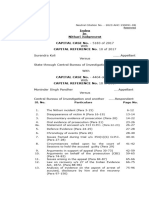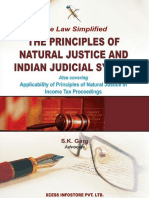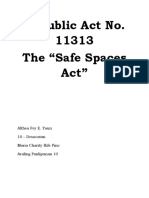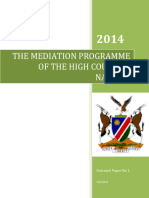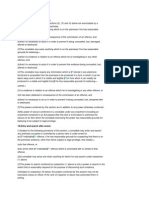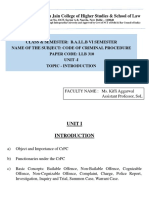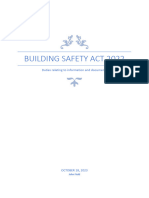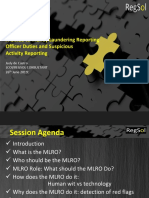DEFAMATION - BASIC CONCEPTS,
CAUSES OF ACTION, ELEMENTS, AND DEFENCES
DASHAMI SUNIL
SAP ID: 8102100657
2021- 2026 Batch
NMIMS Hyderabad
Abstract
Defamation is a tort that occurs when someone's reputation is harmed. It is the act of causing
injury to another person's reputation by making a false statement or telling a negative story to
a third party. Libel and slander are the two types of defamation. The primary difference
between the two is that libel is directed at the sight, whereas slander is directed at the ear.
Slander is the temporary publication of a slanderous statement. It could be spoken words, for
example. Libel is a permanent depiction, such as writing, printing, or a photograph.
Defamation is a civil wrong, often known as a tort. Five important factors must be present to
show defamation: a factual assertion: A statement made public, the statement was hurtful,
and the assertion must be false. The statement is not confidential, and obtaining legal advice
is necessary. There are certain defenses that a person might use to avoid being held liable for
defamation damages. Truth, Fair and bona fide remark, Privilege, Apology, and Amends are
among the defenses. Under Sections 499 and 500 of the IPC, defamation can be a civil or
criminal accusation.1
Section 499 of the IPC2 states that anyone who makes or publishes any imputation
concerning any person, whether spoken or intended to be read, or by signs or visible
representations, intending to harm, or knowing or has cause to suspect that such an
1
AIR 2016 SC 2728
2
Shreya Singhal vs Union of India, AIR 2015 SC 1523.
�imputation would affect that person's reputation, that person's reputation is said to be
defamed.
Section 500 of the IPC states that anyone who defames another person faces simple
imprisonment for a term of up to two years, a fine, or both. The purpose of defamation law is
to protect people's reputations from unfair attacks. In practice, it has the primary effect of
stifling free speech and shielding powerful people from scrutiny. People can sue those who
say or publish false and malicious comments under defamation law.
WHAT IS DEFAMATION?
When someone's reputation is hurt in public, it is called defamation. It involves creating a
false statement or relaying a bad story to a third party to harm another person's reputation.
Defamation3 is when someone's right to a good name is violated. Defamation comes in two
forms: libel and slander. The key distinction is that libel is intended at the eyes, whereas
slander is directed at the ears. The temporary dissemination of a defamatory statement is
referred to as slander. It might, for example, be spoken words. A permanent portrayal, such as
writing, printing, or a photograph, is referred to as libel. Defamation is a civil wrong that is
commonly referred to as a tort. To prove slander, five crucial characteristics must be present:
a statement of fact the following is a statement that was made public. The remark was
insensitive. There are certain defenses that a person might use to avoid being held liable for
defamation damages.
Only special damages can be recovered in a slander case; however, certain countries do not
make this difference. Defamation is illegal by law under a variety of legislation, but it must
be done in a way that directly harms the public interest. The veracity of the publication is
frequently used as a defense to a defamation accusation. Liability is also shielded by legal
privilege deriving from a unique connection or position (Senators, for example, are immune
from prosecution for anything they say on the Senate floor). Under the notion of "fair
comment and criticism," the media has extensive latitude in some areas, although such an
opinion must be about a person's job and not about personal matters, and it must be factually
truthful.
Defamation is the publication of a statement that reflects negatively on a person's reputation
and tends to bring him down in the estimation of right-thinking members of society in
3
Defamation, 3 Encyclopaedia Britannica (Encyclopaedia Britannica Inc., U.S.A., 2007).
�general, or tends to bring him down in the opinion of right-thinking members of society in
particular.
TYPES OF DEFAMATION
We have two options for disseminating the damaging message. One is based on slander,
while the other is based on libel. Libel is a type of permanent deformation that is carried out
through the use of words or graphics. As a result, it may be claimed that it will last as long as
graffiti, monument, or painting does.
Slander may also be used to defame someone. Slander is described as temporary or non-
permanent in this context. As a result, the effect of defamation in this circumstance is judged
to last throughout the statement or conduct.
A. Slander
Slander can also be carried out in a manner that closely resembles libel. For example,
if you dictate defamatory remarks to your clerk, who then puts them on letterhead, the
third person will be communicated through the speech. As a result, in this scenario,
the mode of transmission is deemed transitory.4
B. Libel
To be termed libel, the proof in question must be proven to be defamatory, untrue,
made public, or in writing. The plaintiff should be mentioned in the defamatory
statement, either directly or indirectly. In addition, this comment should make a
plausible relationship between the individual and the statement. Though it is not
required, nor is it the defendant's aim, that individual should be identified directly.
Defamation against a category or a deceased individual, such as doctors, is not
permitted. In these sorts of situations, if the defamation damages the reputation of a
live person, that individual will be prosecuted for defamation.
What Is The Difference Between "Slander" And "Libel"?
The main distinction between the two types is that the libel kind of defamation has written
proof and hence is actionable in and of itself. However, in the case of slander, the offended
party must offer irrefutable proof. The same distinction was used while claiming exceptional
4
The Defamation (Amendment) Act, 2004, Pakistan, available at:
http://infopak.gov.pk/Downloads/Ordenances/Defamation_Ordinance_2002.pdf (last visited on February 9,
2016)
�damages (any material damage which can be estimated in monetary terms or loss of money).
Another popular remark is that slander can be an inadvertent outcome of any provocation in
the heat of any manufactured or contrived incident, but libel indicates clear mala fide intent
with the desire to destroy an individual's or entity's reputation.
BASICS CONCEPTS OF DEFAMATION
Defamation is the harm done to a person's reputation. If a person damages another's
reputation, he does so at his own risk, just as if he interferes with their property. A person's
reputation is his property, and it is potentially more valuable than other assets. Defamation is
defined as any deliberate false statement, whether written or spoken, that destroys a person's
reputation, diminishes a person's respect, esteem, or confidence, or generates disparaging,
hostile, or unpleasant ideas or sentiments against a person.5
Criminal and Civil Defamation
a. Criminal defamation is the act of offending or defaming another person by
committing a crime or offense. You could always prosecute the person or
entity that is responsible for the defamation. It is investigated as criminal
conduct under the IPC.6
b. Civil Defamation: Although civil defamation is not a criminal offense, you
may be able to sue the person who defamed you to obtain legal
compensation for your defamation. It is investigated under tort law, i.e. as a
civil wrong.
Case Laws
a. Youssouf v. MGM Pictures Ltd
The complainant (who is also a Princess) claimed that she was mistaken for
Princess Natasha from the film "Rasputin, the Mad Monk." Because the film
implied that she had been captivated by Rasputin because of her connection
with 'Princess Natasha.' If the DVD showed any interactions between Rasputin
and 'Natasha,' the defendant said, it meant Natasha was raped, not seduced.
5
Ratanlal and Dhirajlal, The Law of Torts 279 (LexisNexis, New Delhi, 26th in., 2013).
6
(1891) 2 CH 269.
� Held- In a cinema picture, the photographic portion and the speech that
synchronizes with it are deemed libelous. Defamation can include words that
cause a person to be shunned or avoided, according to Sesser LJ: 'not only is
the matter defamatory if it brings the plaintiff into hatred, ridicule, or contempt
because of some moral discredit on [the plaintiff's] part, but also if it tends to
make the plaintiff hateful, ridicule, or contemptible.
b. In D.P. Choudhary v. Kumari Manjulata
Manjulata, the plaintiff and respondent, was around 17 years old and came
from a well-known family. She studied B.A. Last night, she went away with a
lad named Kamlesh, according to a news item in the local newspaper Dainik
Navjyoti; nevertheless, she had gone to night courses. The news article was
false and was published carelessly and irresponsibly. Others were taken aback
and mocked her. It was determined that the action was defamatory, and she
was entitled to general damages of Rs 10,000/-.
ELEMENTS OF TORTS
1) The Statement should be made: Words, whether spoken or intended to be read, signs
or tangible representations can all be used to make a point. For example, X is
questioned about the theft of Y's diamond jewelry. X points to Z with the intent of
convincing everyone that Z stole the diamond necklace. This is a form of
defamation.7
2) The Statement must be defamatory: Defamation occurs when someone makes a false
and unfavorable comment, and the individual who makes the defamatory statement
may be held accountable. A defamatory speech is likely to undermine others' good
faith in the individual, and it has the potential to cause social or other people to regard
him with derision, hatred, fear, or dislike. Abusive language can sometimes be
defamatory, such as calling a guy a hypocrite or a persistent alcoholic. A few
examples to help you grasp what constitutes a defamatory comment and what does
7
Available at: http://copyright.lawmatters.in/2012/02/defamation.html (last visited on Feb. 9, 2016)
� not. To claim that a driver is irresponsible is a defamatory allegation. It is not slander
to critique products. It is libelous to suggest that a baker's cake is usually unpleasant.
3) The Statement must refer to the plaintiff: The defamatory comment must be directed
at the individual. The reference may be inferred or explicit. If the plaintiff can still be
identified, the plaintiff's name does not need to be revealed. The individual named in
the defamatory statement might be alive or dead; however, a defamation claim on
behalf of a deceased person can only be filed if the person submitting the complaint
has an interest in the deceased person.
4) The intention of the wrongdoer: The person making the defamatory statement is
aware that a third party hearing the statement would believe it to be genuine, inflicting
damage to the person's reputation and exposing the person to defamation.
5) The Statement should be false: Defamation is defended by the truth; hence a
defamatory statement should be untrue. Defamation requires the untruth of the
statement to be present, thus if the statement is accurate, there is no defamation. The
law does not penalize someone for telling the truth, no matter how unpleasant it is.
6) The Statement should not be privileged: In some cases, the statements may be
privileged, which means that the person who made the statement is protected from
responsibility.
7) The Statement must be published: The statement must be published, that is,
conveyed to a third party, for defamation to occur. Any comment made as personal
communication or written in a personal journal does not constitute defamation, but it
is deemed defamation if the sender knows that a third person may see it. The
perpetrator was held accountable in the case Mahendra Ram v. Harnandan Prasad
because he sent a defamatory message written in Urdu while knowing that the
plaintiff could not understand Urdu and that the letter would eventually be read by
someone else.8
8) The third party believes the defamatory matter to be true: The other members of
society to whom the remark was made think the defamatory thing about the plaintiff is
accurate.
9) The Statement must cause injury: The plaintiff should be harmed or injured in some
way as a result of the person's remark.
Anti-Defamation Remedy
8
Subramanian Swamy v. Union of India (Writ Petition (Crl.) No. 184/2014), available at:
http://supremecourtofindia.nic.in/outtoday/wr18414p-2014_10_30.pdf (last visited on Feb. 9, 2016).
�As we've seen, defamation is a criminal offense as well as a civil wrong. This implies that a
person who has been defamed has the option of using both remedies. He has the option of
filing a criminal complaint under Section 499 of the Indian Penal Code, which defines
defamation. Conviction under this clause carries a penalty of up to two years in jail, a fine, or
both. A person who has been defamed can, on the other hand, initiate a civil complaint about
damages. The amount of damages is determined by variables such as the nature of the
statements, the amount of loss, and so on. Many celebrities, politicians, and well-known
people are suing for defamation damages in the millions of rupees.
DEFENSES AGAINST DEFAMATION
There are certain defenses that a person might use to avoid being held liable for defamation
damages. Some examples of such defenses are as follows:
I. Truth: The most crucial defense or justification for defamation is the truth. This is
because only untrue remarks made against a person are considered defamatory. As a
result, if the individual making the remarks can establish that they are accurate, he
will not be held liable. However, in criminal defamation trials, this defense may not
be available. The defendant is always solely responsible for demonstrating the
accuracy of a statement. Furthermore, he must demonstrate honesty in substance
rather than in the abstract. He cannot use the defense of thinking it to be true in his
mind if the statement is untrue.9
II. Fair and bona fide comment: In a defamation case, the defendant might use the
defense of making a fair and genuine remark. As a result, offering fair and
acceptable criticism without malice does not constitute defamation. Making
accusations criticizing maladministration by a government cabinet minister, for
example, may not be considered defamation. In this scenario, the defendant must
show that he did not have mala fine intents. He must also demonstrate that his
words were made with good intentions.
III. Privilege: In some circumstances, the law may award special rights to specific
individuals. Any words made by someone with such privileges cannot be
considered defamatory. A Member of Parliament, for example, enjoys unlimited
privilege over whatever speech he makes in the House of Commons. For such
9
Mehmood Nayyar Azam v. the State of Chhattisgarh (2012) 8 SCC 1
� utterances, the Constitution offers total immunity from defamation charges. In some
cases, such rights exist in court procedures as well.10
IV. Apology: If the individual who made the defamatory statement then apologizes, he
can avoid reparation obligation. For this defense to work, the individual who has
been defamed must accept the apology.
V. Amends: Amends are valid defamation defenses under English law. Amends refer
to the defendant's defamatory words being corrected or retracted. For example, a
newspaper that makes a false assertion about a person may subsequently release a
correction.11
WHAT IS THE INTERPRETATION OF THE SUPREME COURT ON DEFAMATION?
Judges are occasionally perplexed when problems arise between making a defamatory remark
and exercising one's right to free speech. Dr Swamy challenged the validity of India's
criminal defamation statute in Subramanian Swamy versus Union of India. The Supreme
Court's two-judge bench of Justices Dipak Mishra and P. C. Pant upheld the constitutional
validity of Indian Penal Code sections 499 and 500(criminal defamation), stating that an
individual's fundamental right to dignity and reputation "cannot be ruined solely because
another individual can enjoy his freedom." The presiding judge stated that "people's right to
freedom of speech and expression is not an absolute right, but it is sacrosanct," and that it
must be "balanced with the right to reputation," which is protected under Article 21 of the
Indian Constitution, and that it cannot be sacrificed on the altar of another's right to free
speech. The court determined that criminalizing defamation is necessary to defend individual
dignity, life, and reputation and that it falls within the category of "reasonable limitation" on
the basic right to free speech and expression. As a result, defamation's criminal elements are
legally acceptable and do not interfere with the right to free expression. The Supreme Court
further highlighted that criticism was not defamation, and that a trial court must scrutinize a
complaint "extremely carefully" before issuing a summons in a criminal defamation case.12
10
Umesh Kumar v. State of Andhra Pradesh (2013) 10 SCC 591
11
[1986] SCC 46; Supreme Court of Canada [1986] 1SCR 103
12
AIR 1962 SC 159.
�CONCLUSION
The goal of defamation law is to safeguard people's reputations. Its primary issue is how to
balance this goal with opposing demands for freedom of expression. Because both of these
interests are highly valued in our culture, the former is possibly the most coveted trait of
civilized humans, and the latter is the bedrock of a democratic society. According to the apex
court, the petitioner has an interim period of eight weeks in which to file a challenge. In the
meanwhile, additional instances have emerged, particularly in the political arena, such as the
defamation action brought against Gogoi and the purported arrest of Kiku Sharda. The ruling
brings the matter to a close, but it also raises some doubts. 13 In a modern economy like India,
for example, criminal measures are acceptable, especially in an era where retributive justice
is being replaced with reformative justice Aside from the rising intolerance in the United
States, where retributive justice is being replaced with reformative justice Aside from the
nation's rising intolerance, there is another issue that may be exacerbated as a result of this
decision. Of course, this has been discussed previously. However, because of the chilling
effect that restorative justice may have where retributive justice is being replaced. Aside from
the rising intolerance in the United States. Another issue that may be exacerbated as a result
of this decision is the nation. It becomes necessary to let go of inhibitions and consider
potential options in such circumstances. One such example is in this case, the right to respond
is a proposition. Of course, this has been discussed previously. However, because of the
chilling impact that may be imposed on the Individual/organization; the freedom to respond
has only heightened the scepticism. Right to respond, on the other hand, appears to be a more
civilized way of dealing with a situation than leaping to conclusions, convicting, and
collecting damages. This has been ingested by certain US states and other nations. Certainly,
we can make use of this principle as well. The conversation has led us to the conclusion that
when it comes to constitutional interpretation, the stakes are quite high and grow more
elevated It is far easier to criticize than to go into the details of a situation. Of course,
constructive criticism encourages innovation and progress. Nowadays, getting a job is
simple14. Rather than getting to the heart of the subject, use a critical perspective. It also can't
be overlooked that the judiciary makes every effort to establish a harmonious structure in
13
Editorial, “Arrest of a comedian” The Indian Express, January 15, 2016.
14
Samudra Gupta Kashyap, “Tarun Gogoi appears before court in Rs 100 crore defamation case” The Indian
Express, January 18, 2016.
�such cases. As citizens, we must have a responsibility, and it is past time for us to take stock
of our situation.
